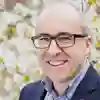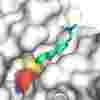
We spoke to Dr Laura Soucek about perseverance and self-belief, the importance of taking risks on bold research, and how your support helped her beat the odds to develop a new cancer treatment that has been referred to as drugging the undruggable.

There is a molecule in our cells called MYC that drives tumour growth in 70% of all cancers. A drug that targets this molecule could therefore be game-changing with the ability to treat a wide range of patients.
Scientists have been searching for a way to achieve this for decades, and it seemed impossible. But Dr Laura Soucek didn't believe that was the case, and she proved it when the treatment she developed, called Omomyc, began being used to treat patients in clinical trials that started in 2021 – eight years after the project we originally funded.
Dr Soucek is no stranger to overcoming challenges.
Back in 2013, she was newly based at a lab in Barcelona, where she hoped to further develop Omomyc. The first non-Spanish person leading a lab in her institution, and also the first woman, Dr Soucek was trying to establish herself in a new country and learn a new language at the same time, while continuing to do her job.
But she was also facing scepticism from cancer experts all over the world who maintained that Omomyc was just a proof of concept, and that it could never be turned into a working drug. It was a struggle to find any support to keep doing this crucial work that she believed in so strongly, despite her strong preliminary data.
Fortunately, taking a calculated risk on outside-the-box thinking is what Worldwide Cancer Research do best.
Dr Soucek applied for funding, which we awarded, and the project delivered the proof of principle that Omomyc represented a promising new treatment strategy for lung cancer, as well as potentially many other types of cancer. That research is now heading towards having a real benefit for cancer patients.
Dr Soucek's timeline of discovery:
-

My career started in Rome...
...at Sapienza University, where I studied Biological Sciences and earned a degree cum laude. I then decided to pursue a PhD in genetics and molecular biology, and this is where I realised what my passion was, when I chose to focus on the gene called MYC. -

I knew there was an opportunity from the very beginning...
...I thought inhibiting MYC would be really beneficial in our fight against cancer, but people told me that I was crazy and that it was an undruggable target. But I believed that it was possible, so I continued working to develop a treatment, which I called Omomyc. -

My initial results were clear...
...showing that Omomyc had a dramatic impact on cancer cells, and only mild, well-tolerated, completely reversible side effects on normal tissues. So I packed my bags and from Rome I travelled to San Francisco for a one-year fellowship. -

One year turned into ten...
...and in 2008 we made our first publication, showing that Omomyc could be extremely effective in making tumours shrink and disappear, with no severe side effects. This was something nobody expected, but still there was doubt. People started saying these tumours were not complex enough to really represent human tumours. -

So I moved again, this time to Barcelona...
...to the Vall d’Hebron Institute of Oncology, where we had the opportunity to test Omomyc on human tumours. The first proof of concept was extremely difficult, using glioma and glioblastoma (brain tumours), where we managed to show that again, Omomyc worked. For me, this was the final proof that this was a treatment that could have real benefit for cancer patients. -

But I faced more scepticism...
...and reviews were being published by experts from all over the world arguing that Omomyc was just a proof of concept - that it was a molecule too big and bulky to be directly delivered to cells so, essentially, it could never be a drug. This was really frustrating to me at the time. -

In 2013 Worldwide Cancer Research took a chance...
Their grant allowed our project to continue, and we found out that, despite what everybody had thought, Omomyc could be a pharmacological tool, and that it was able to penetrate the nuclei of cells, attack MYC, and kill cancer cells without damaging normal tissue. This was enough to patent Omomyc for use in medicine and cancer. -

The next big milestone was in 2021...
...when we were able to finally bring Omomyc to clinical trials. A phase one clinical trial is designed with the safety of patients in mind, so all the patients involved are those who have exhausted all other treatment options, and you have to start with a very, very low dose of the drug, which then allows you to find the ideal dose at which your drug works. -

We didn't expect any effect on patients at that first level, or even the second...
...but we actually had a surprise at level two. There was a patient with advanced metastatic pancreatic ductal adenocarcinoma, one of the most difficult types of cancer to treat, and this patient entered the trial at this level and his disease stabilised and stopped growing. This could have been a coincidence, but then at level three, another patient stabilised, and then we started seeing it happen more often, until we essentially saw stabilisation of the disease in half of the patients who had entered the trial. -

So what will happen next?
We have different clinical trials ongoing past the initial phase one trial. One specifically in first line metastatic pancreatic ductal adenocarcinoma patients because we really think we can make a difference for this very difficult to treat cancer, and we also just started a clinicial trial for advanced osteosarcoma, which is a rare paediatric cancer. This is hopefully just the start!
The great opportunity that we have here, inhibiting MYC, is the opportunity to intervene on different types of cancer. MYC is a common factor that basically instructs cells to divide in all types of cancers, so attacking MYC is a little bit the opposite of personalised medicine because it gives us the opportunity to intervene in different types of tumours independently of the mutations that these tumours can have, or even their location.

Donate today to start new cures
Be part of the united effort to stop lives being cut short by cancer.




